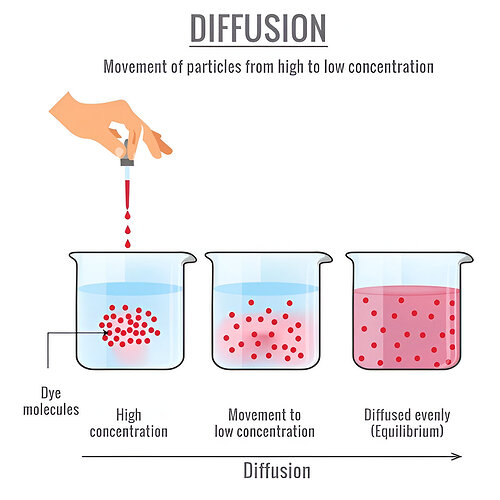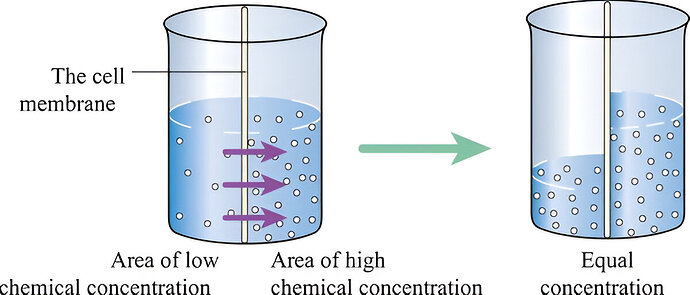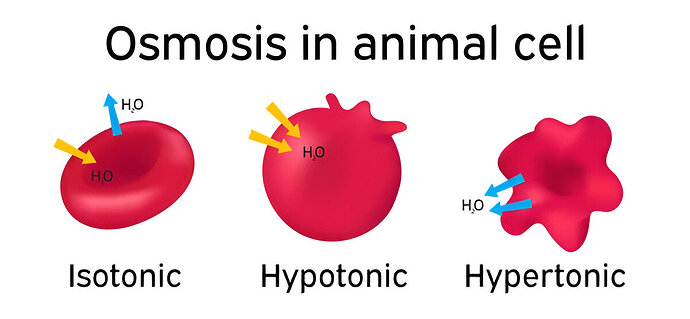In yesterday’s CUBE ChatShaala, Seethalakshmi try to explain the difference between Diffusion and Osmosis, However it made hard difficult to expressing it . Just like Seethalakshmi, students used to get confused and overwhelmed to understand the concept . We make them understand by using Everyday Example . This helps them to understand with context and can related to thier every day activity. For context :
Have you ever wondered how water knows where to go? Or why salty chips can shrivel up a slice of cucumber? ![]() Let’s explore the fascinating world of diffusion, osmosis, and tonic solutions — all happening quietly around (and inside) us every moment!
Let’s explore the fascinating world of diffusion, osmosis, and tonic solutions — all happening quietly around (and inside) us every moment!
 Diffusion: The Dance of Molecules
Diffusion: The Dance of Molecules
Diffusion is the natural movement of particles (like gases or solutes) from a place where they are crowded (high concentration) to where they’re fewer (low concentration).
No extra energy needed — it’s all passive!
![]() Everyday Example:
Everyday Example:
- Perfume spreading in a room.
- Sugar dissolving evenly in water.
![]() In Cells:
In Cells:
- Oxygen diffusing into our blood from the lungs.
 Osmosis: Water’s Secret Superpower
Osmosis: Water’s Secret Superpower
Osmosis is a special type of diffusion — it’s all about water!
Water moves across a semi-permeable membrane (like a cell membrane) from a region of low solute concentration (more water) to high solute concentration (less water), trying to “balance” both sides.
![]() Everyday Example:
Everyday Example:
- Soaked raisins swell up as water moves in.
- Wilted vegetables getting crisp in plain water.
![]() In Cells:
In Cells:
- Water entering plant root cells from the soil.

 Isotonic, Hypotonic, and Hypertonic: Tonicity Explained!
Isotonic, Hypotonic, and Hypertonic: Tonicity Explained!
Tonicity tells us how water moves when cells are placed in different solutions. It’s all about solute concentration outside vs. inside the cell.
 Isotonic Solution (Equal Concentration)
Isotonic Solution (Equal Concentration)
- No net movement of water.
- Cell stays the same size.
![]() Example:
Example:
- Saline used in IV drips (0.9% NaCl) — safe for blood cells.
 Hypotonic Solution (Less Solute Outside)
Hypotonic Solution (Less Solute Outside)
- Water moves into the cell.
- Cell swells and may burst (in animal cells).
![]() Example:
Example:
- Pure water around a red blood cell — the cell may burst!
- Soaked dry fruits puff up in water.
 Hypertonic Solution (More Solute Outside)
Hypertonic Solution (More Solute Outside)
- Water moves out of the cell.
- Cell shrinks (plasmolysis in plant cells).
![]() Example:
Example:
- Salt sprinkled on cucumber — draws out water.
- Honey used on wounds — pulls out water from bacteria!
 Summary Table:
Summary Table:
| Concept | What Moves? | Direction | Real-Life Example |
|---|---|---|---|
| Diffusion | Molecules | High → Low | Smell of perfume in a room |
| Osmosis | Water | High → Low (of water) | Soaked raisins swelling |
| Isotonic | – | No net water movement | IV saline solution |
| Hypotonic | Water | Into the cell | Fresh water around red blood cells |
| Hypertonic | Water | Out of the cell | Salting vegetables before cooking |

 Why It Matters:
Why It Matters:
These tiny molecular movements keep our bodies balanced, plants upright, and food science interesting!
Whether it’s staying hydrated, making pickles, or saving lives with IV fluids — osmosis and diffusion are quietly shaping our world.
![]()
![]() Now that you know the secret behind “The Great Water Escape,” can you spot osmosis in your kitchen or garden today?
Now that you know the secret behind “The Great Water Escape,” can you spot osmosis in your kitchen or garden today? ![]()
@Arunan @KiranKalakotiR @2020ugchsncnseethala @Enas_188 and others.


